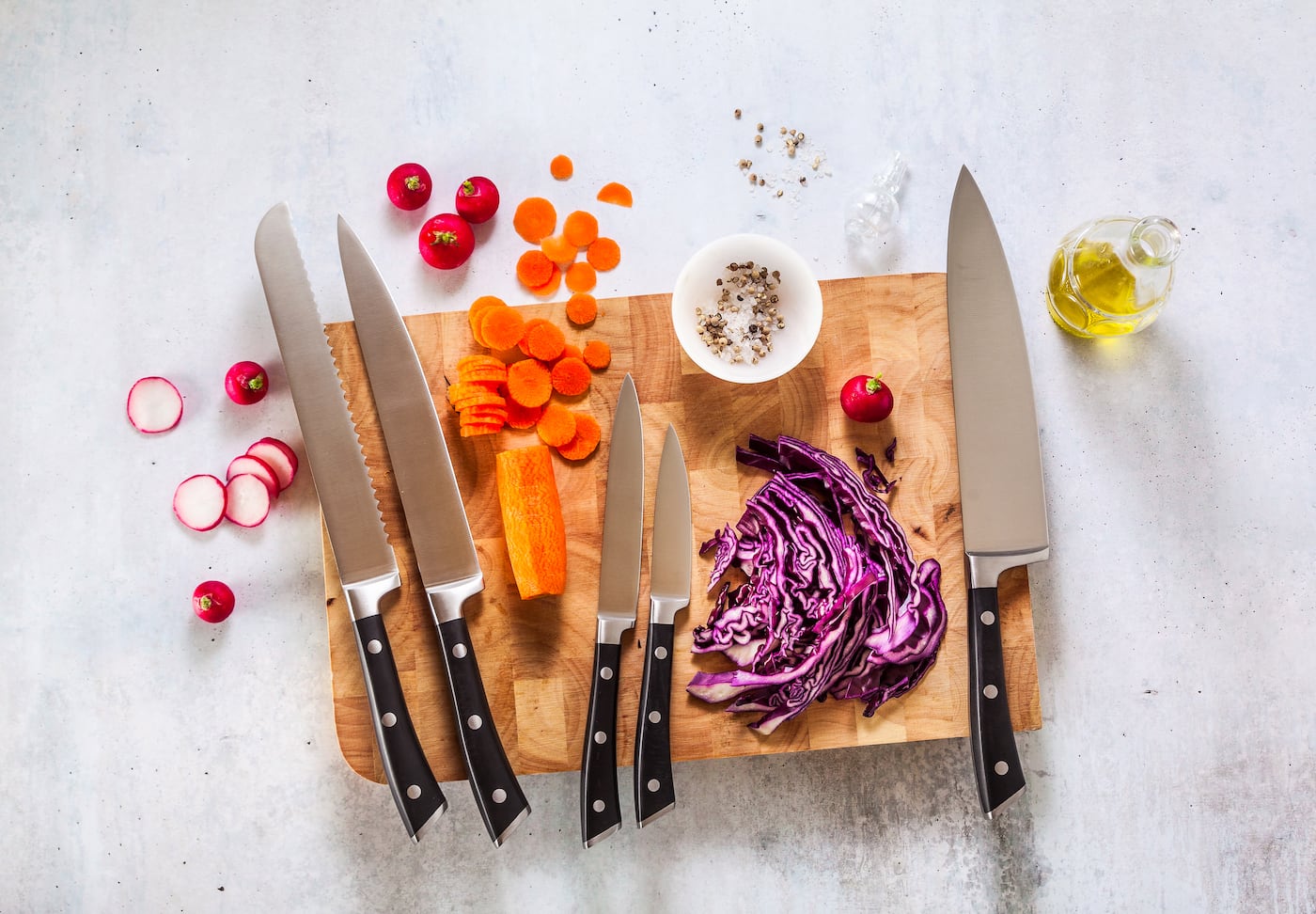Many a chef's heart beats faster at the sight of beautiful kitchen knives . Knives come in all shapes and sizes, and each type has its own purpose. After reading this blog, you'll know when to use which type of kitchen knife.
[product=kitchen knife]
This knife is not only razor-sharp but also beautifully balanced, making every cutting task easier. Ideal for both professional chefs and home cooks striving for perfection in every cut.
[/product]
A different type of knife for every task
In the kitchen, a knife is an indispensable tool. You use it daily, and you probably own several. It's important to know which knife to use for which task. Using a good knife ensures efficiency and speed, as well as the best results.
Before we explain the different types of kitchen knives, it might be helpful to understand the components a knife is made of. A knife always consists of the same parts, but these parts vary in size or shape. By varying the shape or size of these parts, you create knives that are ideally suited for specific applications.
Parts of a knife
Every knife consists of a number of fixed elements. Before we can explain the differences between the different types of kitchen knives, it's helpful to understand the components that make up a kitchen knife.
| Spine of the blade | Generally, the back of a knife is straight and smooth. A ribbed back is usually used for descaling fish. |
| Blade | The blade determines the final quality of the knife. Therefore, an alloy of iron and other materials is used. |
| Head | Important for protecting your hand, preventing your fingers from slipping off the edge. Also known as a "guard plate." |
| Tang | The extended portion of the blade where the handle, bolster, and pommel are attached. A good knife consists of a single piece, a so-called "full tang," extending all the way to the pommel. |
| Cut | As the name suggests, this is the part of a knife used for cutting. It's the sharp part of a blade. |
| Fold | The beveled edges along the cutting edge. The angle at which the fold is ground creates the knife's characteristic cutting properties. |
| Heel | The back of the edge. This is usually only sharpened when the kitchen knife has a small bolster. |
| Handle | The part where the knife is held, the handle. A handle can be made of various materials, such as wood, metal, or plastic. A good handle ensures a kitchen knife fits comfortably in the hand. |
| Pommel | The back of the handle, this part provides a counterweight to the blade. It's an important component for the knife's balance. |
The most important kitchen knives
An overview of the most commonly used types of kitchen knives.
Chef's knife / Chef's knife
A chef's knife should be a staple in every kitchen. You can recognize this type of knife by its sturdy, wide blade that tapers to a point with a slight curve.
[product=chef's knife]
Available in two sizes, this knife offers excellent balance and a comfortable grip, making preparing dishes both easy and enjoyable.
[/product]
The high blade allows the knife to glide past the knuckles of the hand holding the ingredient while slicing, allowing you to slice quickly but safely.
A chef's knife has a sharp point, so it can also be used for delicate work. It's a true all-rounder, making it a chef's most important tool. You can use it to cut vegetables, fish, and meat, but you can also use it for chopping herbs. A chef's knife can vary in length from 15 centimeters to as long as 36 centimeters.
Santoku knife
San to ku is Japanese and means "three advantages." The santoku knife is a Japanese chef's knife and can be used for preparing meat, fish, and vegetables, making it similar to a Western chef's knife.
[product=mes-santoku]
Experience the difference with the Hendi Santoku knife. A perfect blend of tradition and quality, this knife is a must-have for every serious chef and kitchen enthusiast.
[/product]
The santoku has a wide blade, requiring a different cutting technique. With this knife, you cut straight from top to bottom. You lift the knife from the cutting board each time. This is different from a traditional chef's knife, which cuts with a rolling motion. Read more about cutting techniques .
Choosing a regular chef's knife or Santoku?
Whether you prefer a standard chef's knife or a santoku knife is largely a matter of personal preference. Cutting ingredients varies, and neither type of kitchen knife is ideal. One thing is certain: no serious chef should be without at least one of the two.
Office knife
The paring knife is essentially a smaller version of the chef's knife. Like its bigger brother, it's a true all-rounder, but the paring knife excels at more delicate tasks.
The paring knife has a narrow blade, a straight edge, and a sharp point. The blade length is usually between 9 and 13 centimeters. This type of knife is used for peeling fruit or cutting vegetables.
Meat knife / carving knife
A carving knife is used for cutting (slicing) large cuts of meat. It's a long, sharp knife that easily slices ham or roast beef. A carving knife is best used with a carving fork , so you don't have to touch the hot meat with your fingers.
[product=carving knife]
Looking for the perfect tool for slicing meat and poultry? This carving knife from the Kitchen Line collection offers excellent sharpness and balance for a precise cut.
[/product]
Bread knife
The bread knife , sometimes also called a baker's knife or simply a serrated knife, is indispensable in the kitchen. The serrated blade makes this type of knife ideal for slicing bread. The pressure of the knife is concentrated on the serrations, preventing the bread from being crushed when slicing.
[product=bread knife]
This bread knife features a sharp, serrated blade, ideal for slicing all types of bread without crushing it. Its ergonomic design and balanced grip make it an essential tool in any kitchen.
[/product]
Incidentally, you can also use this knife for other things than just bread. Pies and cakes are easy to cut with a serrated knife. Various fruits, such as pineapple, melon, and even pumpkin, also work well with this type of knife. A bread knife is generally between 20 and 30 centimeters long. The length is important, because the longer the knife, the fewer cutting strokes are required.
Paring knife
A paring knife (turning knife) has a characteristic curved blade. This makes it easier to peel round products. Officially, this knife is used for turning, which is a culinary term for cutting a product, such as a carrot, turnip, or zucchini, into "barrels" so that it has an even thickness throughout and can therefore cook evenly.
[product=paring knife]
Do you know that feeling of struggling with dull knives while cooking? This paring knife from the Kitchen Line series is the solution for every home chef.
[/product]
Which knives do you really need?
A knife block often contains all sorts of knives. Some knives are indispensable in the kitchen, while others have a very specific purpose and are therefore optional.
The following kitchen knives are indispensable
- Chef's knife or a santoku knife
- Office knife
- Meat knife
- Bread knife
- Paring knife
All other types of kitchen knives are more optional and especially handy to have if you regularly have a very specific task. A filleting knife is only used for filleting. If you never do that, you can easily do without one. For example, you don't need a special tomato knife. A sharp chef's knife, paring knife, or a santoku will do just fine for that.
So make sure you have at least the essential types of kitchen knives mentioned above. Then you can tackle almost any kitchen task with ease.



Leave a comment
This site is protected by hCaptcha and the hCaptcha Privacy Policy and Terms of Service apply.